Gerbera aurantiaca
Gerbera aurantiaca Sch.Bip.
Family: Asteraceae
Common names: Hilton daisy
Introduction
The Hilton daisy is a strikingly beautiful grassland plant that occurs around Pietermaritzburg in KwaZulu-Natal. The species is under considerable threat of extinction due to habitat fragmentation and degradation resulting from agriculture and urban sprawl.
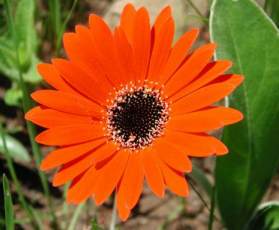
Description
Description
The species is a low-growing herb with thick, thong-like roots, and rosettes of elliptical, dark green, leathery leaves. The plants grow vegetatively by underground stems to form clones which can reach over a metre in diameter and are thought to be hundreds of years old. Plants typically die back during the dry winter months and leaves begin to emerge in spring. As with all daisy family plants, the 'flowers' are not single flowers but a head made up of many tiny florets massed together. The 'petals' (ray florets) are usually a striking crimson, but may be orange, pink or yellow on the upper surface and are coppery below. It is thought by some that the colour variations might have resulted from hybridization with a close relative, Gerbera ambigua. The disc florets in the 'flower' centre appear black or dark purple when the inflorescence opens, changing to yellow as the pollen is presented. Flowering takes place in spring, from September to November, when the daisies form spectacular masses in the grassland.
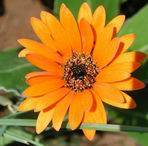
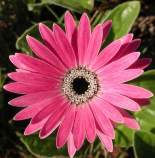
Conservation Status
Status
Endangered
Distribution and habitat
Distribution description
G. aurantiaca is endemic to the mistbelt grassland region of KwaZulu-Natal and is currently known from approximately 9 scattered populations from Helahela in the south to Babanango in the north. This is a summer rainfall area, which experiences very cold winters, often with snow in some localities.Hilton daisies typically occur in rocky grassland between 900 and 1 500 m, on warm slopes in well-drained, shallow soils associated with doleritic formations.Most localities are burnt annually.

Derivation of name and historical aspects
History
The genus Gerbera is named after the German naturalist Traugott Gerber who started the first botanical garden in Moscow in the 1700s. However, to date no one has been able to find any connection between Gerber and the genus.
The specific name aurantiaca is, rather suprisingly, from the Latin aurantiacus or orange-yellow. Perhaps this refers to the coppery orange undersurface of the petals.
The common name is derived from the village of Hilton near Pietermaritzburg, where the daisies once grew in profusion.
A close relative of the Hilton daisy is the well-known Barberton daisy, (Gerbera jamesonii), which is one of the parents of the popular Gerbera hybrids used extensively in the cut flower and nursery trade. The genus Gerbera has approximately 14 southern African species, some of which are found only in Western Cape.
Ecology
Ecology
Gerbera aurantiaca has been selected as the flagship species of the Natal National Botanical Garden's SABONET-funded Threatened Plants Programme. The programme is combining a study of the population biology of the Hilton daisy in the wild, together with the establishment of ex situ populations from the major localities, and the selection and propagation of some of the most attractive varieties for horticulture.
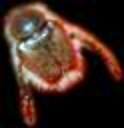
The pollinator of the Hilton daisy is thought to be the brown hairy monkey beetle which feeds on the pollen, and probably uses the flowers as rendevous platforms for mating. The large pollen grains get caught in the hairy body of the insect and are carried to the next flower that the beetle visits where they may be brushed off and pollinate receptive florets. A number of insects feed on the developing seedheads and can severely reduce seed set.
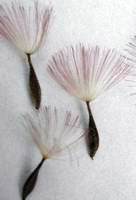
The seeds with their hairy parachutes which aid in dispersal, are carried short distances by the wind. However, seedlings are seldom seen in the wild, although the seed germinates readily.
Uses
Use
The Hilton daisy does not appear to be used for traditional healing purposes. However, as it is such an attractive plant, that in the past, keen gardeners frequently dug plants out of the wild to grow in their gardens. This was virtually never successful and the plants are notoriously difficult to grow in cultivation.
Growing Gerbera aurantiaca
Grow
Please note that the collecting of threatened plants such as the Hilton daisy, or their seed, is prohibited by law. In addition, as mentioned in the previous section, these plants are reputed to be extremely difficult to grow.
However, as part of the Threatened Plants Programme at the Natal National Botanical Gardens, we are studying ways of establishing populations out of the wild for conservation purposes. This involves the cultivation of the plants. Seed collected from the wild germinates well immediately after collection. There is a high mortality in the first year, possibly due to fungal infection. Once established the plants do not like to be disturbed.
References
- HILLIARD, O.M. 1977. Compositae in Natal. University of Natal Press. Pietermaritzburg
- JOHNSON, I.M. 2003. The decline of the daisies. Veld & Flora 89: 31.
- POOLEY, E. 1998. A field guide to the wild flowers of KwaZulu-Natal and the eastern region. Natal Flora PublicationsTrust, Durban.
- SCOTT-SHAW, C.R. 1999. Rare and threatened plants of KwaZulu-Natal and neighbouring regions. KwaZulu-Natal Nature Conservation Service, Pietermaritzburg.
Credits
Isabel Johnson
KwaZulu-Natal National Botanical Garden
August 2003
Plant Attributes:
Plant Type: Perennial
SA Distribution: KwaZulu-Natal, Mpumalanga
Soil type: Loam
Flowering season: Spring, Early Summer
PH: Neutral
Flower colour: Red, Pink, Orange
Aspect: Full Sun
Gardening skill: Challenging
Special Features:
Horticultural zones









Rate this article
Article well written and informative
Rate this plant
Is this an interesting plant?
Login to add your Comment
Back to topNot registered yet? Click here to register.